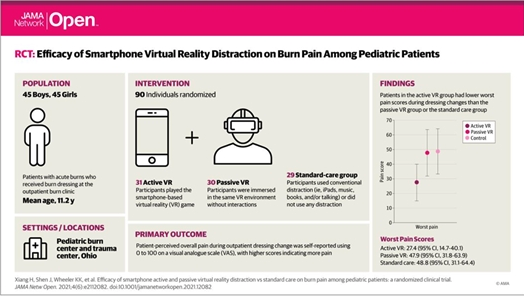VR Games Shows Significantly Reduces Pain for Burned Patients

The wide range of virtual reality applications extend far beyond gaming and entertainment. Many VR startups have attempt to us VR for therapeutic purposes, such as Oxford VR and XR Health.
A randomized clinical trial published on the AMA Network Open found that when children with burns changed their dressings, smartphone-based virtual reality (VR) games had a significant effect on reducing their pain.
According to statistics, there are about 250,000 children burn cases in the United States every year. The pain caused by burns exceeds the trauma itself, and changing dressings can also bring obvious pain. The side effects of opioids with analgesic effects are obvious, and the number of deaths caused by them has been More than the number of deaths caused by traffic accidents." said Xiang Huiyun, professor of pediatrics and epidemiology at the National Children’s Hospital and director of the Children’s Trauma Research Center.
He said that previous studies have proposed other ways to reduce the pain of burn patients, mainly focusing on distractions, such as music, hypnosis, toys, and VR.
In this study, 90 children with second-degree burns aged 6-17 years old were divided into three treatment groups: active VR group, passive VR group, and standard care group (such as using toys and iPad to distract attention). Patients in the active VR group participated in the game interaction in person, and the passive VR group only watched the same game without interactive participation.
The VR game designed by the research team is called "Virtual River Cruise", which mainly considers two factors. One is snow, which creates a colder environment, and the other is to encourage patients to actively participate.
After the intervention experiment, the researchers conducted a survey of pain perception and subjective experience of patients and their caregivers, and assessed them using the visual analogue scale (VAS, 10-100 points). The study found that the most painful VAS score of patients in the active VR group was 27.4, which was much lower than the score of 47.9 in the passive VR group. The most painful score in the standard care group was the highest at 48.8.
Most patients and their caregivers said this game is fun, fascinating and similar to life experiences.
Xiang Huiyun says “In the past, researchers have used computer games, which are inconvenient for clinical use and difficult to promote and apply. Smartphone-based games are more practical and have more applicable scenarios."
He said that the current opioid crisis has prompted us to use non-opioid methods to control the pain of burn patients. In the future, they hope to evaluate whether smartphone-based VR games have the same protective effect as opioids.

